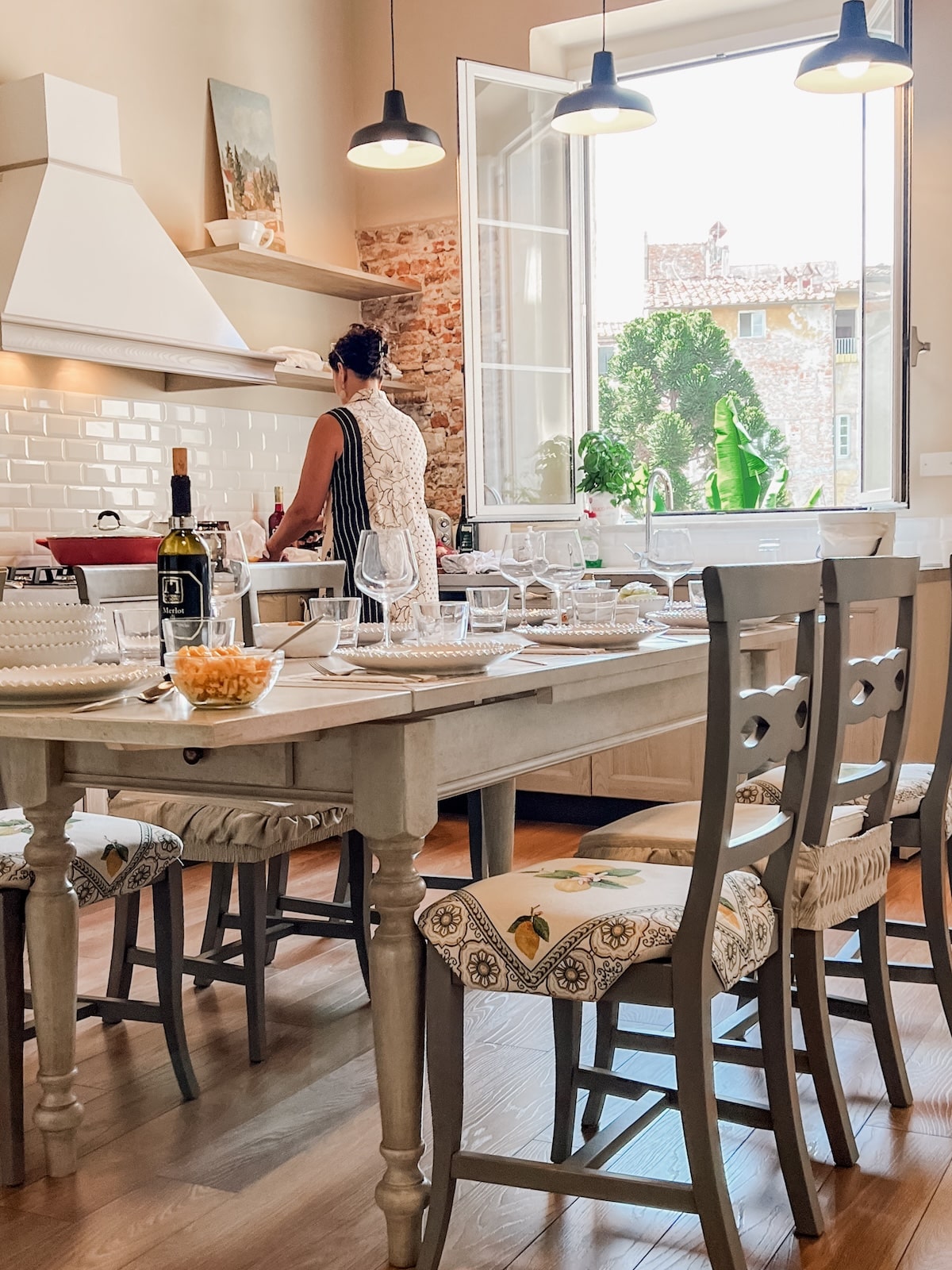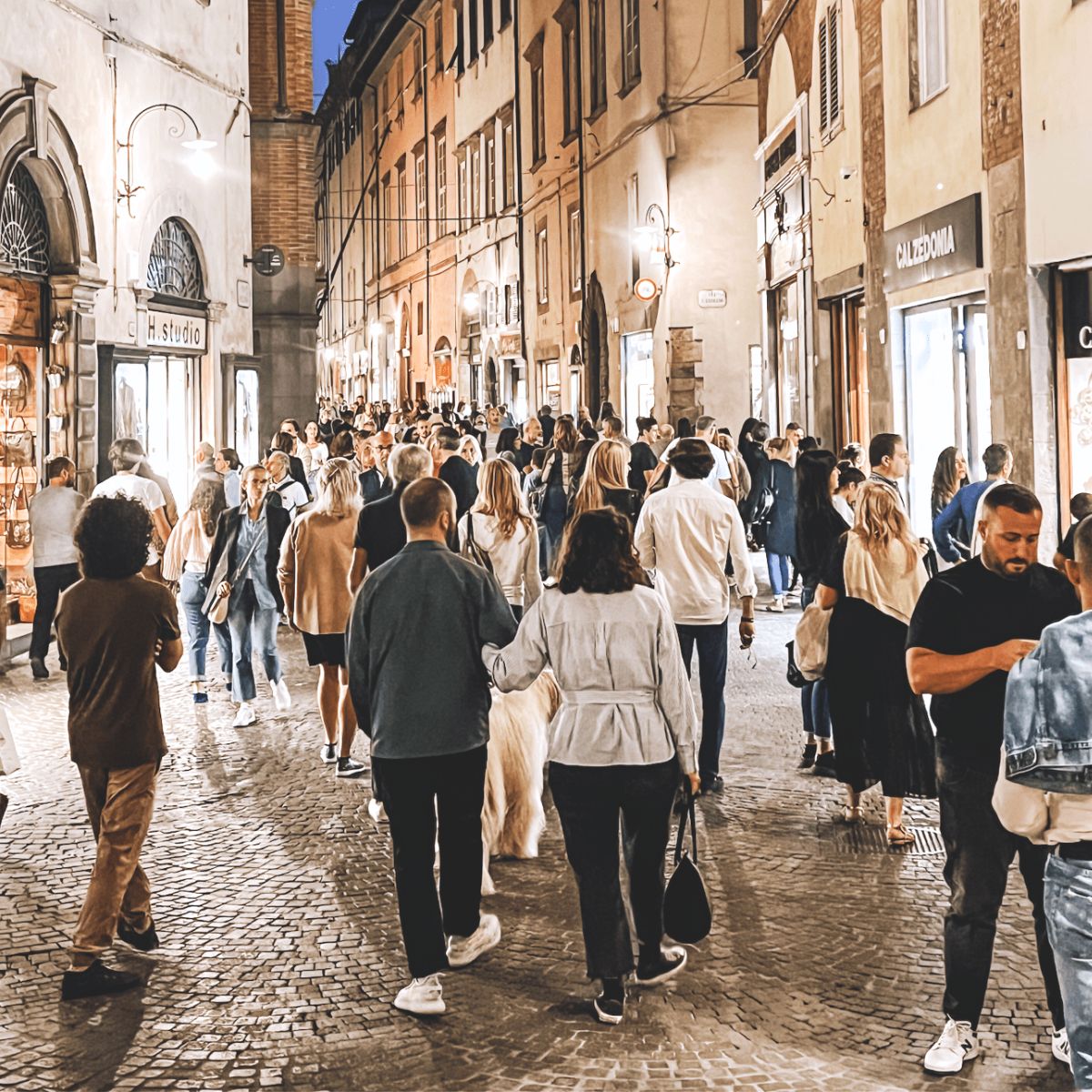What is the best part of Italy to stay in? That answer is completely different for every traveler. Will you be renting a car, relying on public transportation or doing a combination of both? What interests are you most passionate about? This guide takes all of that into consideration and offers some great options to choose from for your Italy trip.
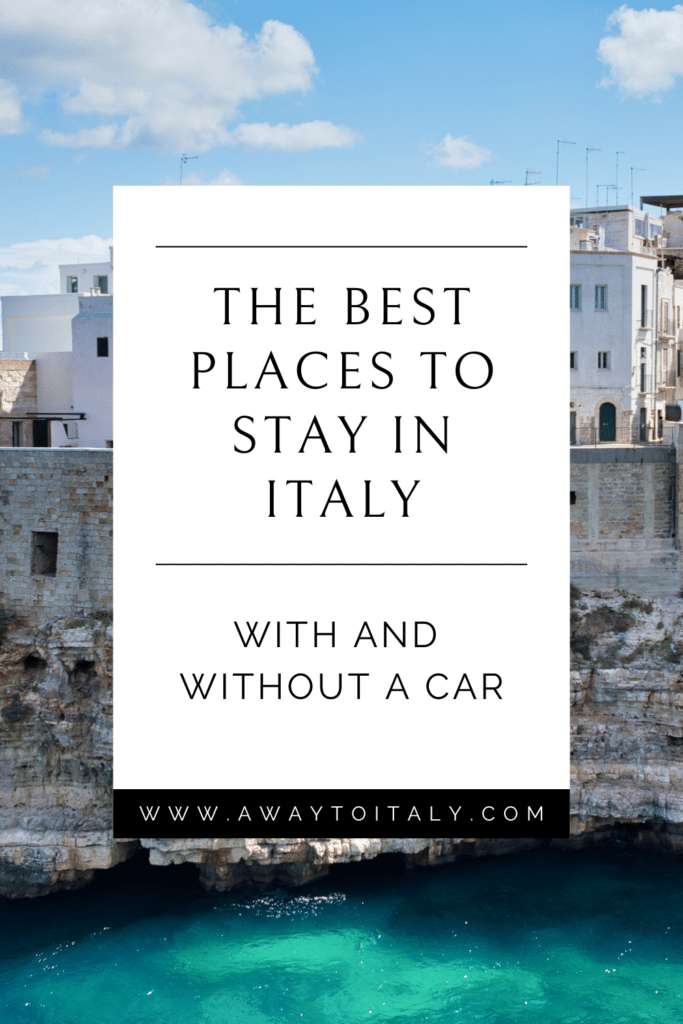
Italy is so compact, yet each region is like a world of its own. Whether you’re traveling from the mountains of the north to the hills of Tuscany, or down to the gorgeous southern coast, it’s like stepping into a completely different experience.
Your home base needs to match your travel style and how you plan to get around—whether that’s hopping in a rental car to explore locations off-the-beaten-path, or relying on Italy’s amazing train system to zip between cities.
Think about what excites you.
Are you a foodie who dreams of spending your days strolling through vineyards, sampling local markets, and maybe squeezing in a cooking class?
Or maybe you’re all about history, and you want to step right out of your hotel into cobblestone streets lined with centuries of stories and world-class museums.
Whatever your style, picking the right place to stay can turn a good trip into an unforgettable one.
By the end of this post, you’ll know exactly how to choose the best base for your Italy adventure—whether you’re traveling with or without a car, and how to find the perfect spot to make your Italy trip as unique as you are.
Renting A Car vs. Taking The Train

Renting a Car in Italy
When deciding whether to rent a car in Italy, there are a few pros and cons. One major advantage is accessibility—having a car lets you reach remote towns and attractions that public transportation may not cover. It also gives you the flexibility to create your own schedule, free from bus or train timetables.
However, driving has its downsides. Cities can be congested, and parking is often difficult to find, especially in tourist spots. Italian drivers can be aggressive, and the narrow, winding roads can be stressful to navigate. Renting a car also adds to your travel costs with fuel, parking, and tolls.
Another challenge is avoiding ZTL (Zona Traffico Limitato) zones, which restrict access in historic city centers. If you accidentally enter one, you won’t know until you’re fined later, often months after you’ve returned home, when the rental company sends the bill.
Traveling By Train
Train travel can make your trip more relaxing by eliminating the stress of driving, traffic, and parking. If you’re staying in a major city, you can still explore less central areas through guided tours and day trips. This also lowers costs since you’ll save on rental fees, fuel, tolls, and parking. Additionally, using public transportation gives you a more authentic glimpse into local life and is often very convenient for getting around major cities.
However, there are some downsides. You’ll have less flexibility in where and when you can travel, and reaching remote areas can be more difficult without a car. While you can book guided tours for day trips, these will add to your overall expenses. Luggage restrictions on public transportation can also be a hassle, especially if you’re traveling with larger bags.
Other potential challenges include navigating the language barrier if you don’t speak Italian, which can make public transportation tricky. Additionally, strikes are relatively common in Italy, potentially causing delays, cancellations, or reduced services on trains, buses, and ferries, which could disrupt your plans.
Further Reading:
• How To Travel By Train In Italy: Expert Tips For A Smooth Journey
Why Choosing the Right Home Base Matters
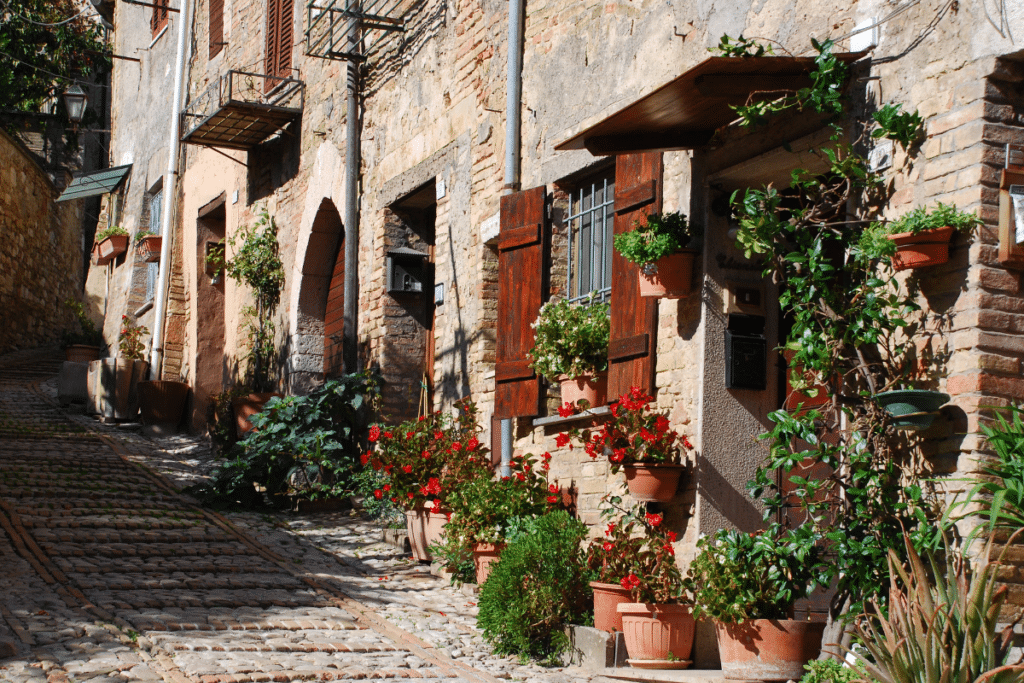
Avoiding Exhaustion
One of the biggest mistakes I see travelers make is staying too far from where they plan to spend most of their time. On paper, it might not seem like a big deal to drive or take the train an hour or more each day. But those daily trips back and forth add up, and before you know it, half your vacation is spent in transit.
Travel Style
Where you stay should match your travel style. Are you someone who likes to hop from one city to the next, checking off iconic landmarks, or do you prefer to settle into one area and explore it deeply? Do you like the energy of being in a city? Or do you crave a peaceful retreat in the countryside?
What Are You The Most Passionate About?
Really think about what lights you up. Don’t put your itinerary together based on a generic guidebook. There is so much to choose from in Italy. This post just scratches the surface of what’s possible, but it’s a very comprehensive starting point. Let’s take a look at the best of what Italy has to offer for a variety of interests, with options to reach them by train or car.
Best Places To Stay In Italy For Food and Wine Lovers
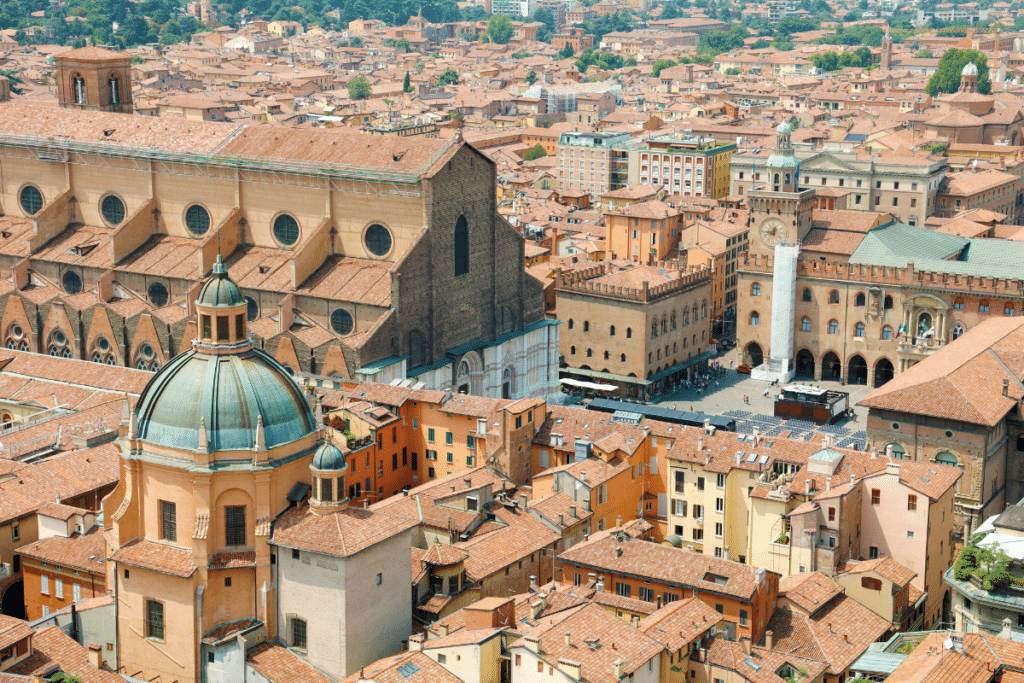
Best Reached By Train: For Food And Wine Lovers
Bologna, Emilia-Romagna (Northern Italy)
Often referred to as the gastronomic capital of Italy, Bologna is a paradise for food and wine lovers traveling by train. Bologna is the birthplace of iconic Italian dishes like tagliatelle al ragù (Bolognese sauce) and tortellini. The city’s vibrant markets, such as Mercato di Mezzo and Mercato delle Erbe, offer a feast for the senses with fresh produce, cured meats, and artisanal cheeses.
Bologna’s central location and excellent train connections make it an ideal base for exploring other Italian culinary hotspots, like Parma and Modena. This region is famous for Lambrusco and Pignoletto wines, Prosciutto di Parma, balsamic vinegar and Parmigiano-Reggiano cheese.
Florence, Tuscany (Central Italy)
Florence is the perfect starting point for exploring Tuscany’s world-renowned food and wine culture. It’s a culinary hub, with excellent restaurants, markets, and access to nearby wine regions. It’s known for its rich Tuscan cuisine featuring dishes like bistecca alla fiorentina, fresh pasta such as pappardelle al cinghiale, and hearty soups like ribollita.
Don’t miss a visit to Mercato Centrale, where you can sample local cheeses, olive oils, and regional wines. Go upstairs at the market to experience its incredible food hall where you can enjoy locals wines, craft beers and freshly prepared dishes from various vendors, ranging from traditional pasta and pizza to more modern street food.
Florence’s train station is well-connected to other Tuscan towns like Siena, Arezzo, Pisa and Lucca. Trains also link Florence to cities Rome, and Bologna for easy day trips.
Naples, Campania (Southern Italy)
Naples is a dream destination for food and wine lovers traveling by train. As the birthplace of pizza Margherita, the city is filled with authentic pizzerias where you can enjoy this iconic dish just as it was meant to be. Beyond pizza, you’ll find incredible seafood, spaghetti alle vongole, and indulgent pastries like sfogliatella and babà. The bustling food markets and cozy local spots offer an authentic taste of Neapolitan life.
Naples also makes a fantastic base for exploring the Campania region. With easy train connections, you can head out to places like the Amalfi Coast, Sorrento, or the wine regions of Avellino and Benevento. The central train station connects you effortlessly to other major Italian cities too, making Naples a perfect starting point for a food adventure.

Best Reached By Car: For Food And Wine Lovers
Langhe, Piedmont (Northern Italy)
Langhe, an area nestled in the beautiful Piedmont region, is a dream come true for food and wine lovers exploring by car. This area is famous for its rolling vineyards that produce world-class wines like Barolo and Barbaresco—and some of finest white truffles are from this area. The local gastronomy is something special, with dishes like tajarin pasta, vitello tonnato, and brasato al Barolo that you can savor in cozy trattorias or even Michelin-starred restaurants.
Alba makes a great home base, known for its vibrant food scene, offering easy access to nearby vineyards and truffle hunting experiences. Having a car gives you the freedom to explore the stunning countryside at your own pace, visiting the quaint villages and wineries that dot the landscape. Plus, Langhe’s central location in Piedmont makes it easy to take day trips to nearby spots like Turin or the breathtaking Italian Alps.
Montepulciano, Tuscany (Central Italy)
Perched on a hilltop in Tuscany, Montepulciano is a dream destination for food and wine lovers exploring by car. This town has everything: incredible wines, stunning views, and authentic Tuscan charm and food. You can experience tastings of Vino Nobile di Montepulciano, a renowned red wine that you can sip in the local wineries and cozy enotecas around town. And when it comes to food, Montepulciano won’t disappoint—imagine digging into pici pasta or a hearty bowl of ribollita at one of the many charming trattorias.
Having a car gives you the flexibility to wander through the Tuscan countryside, exploring vineyards, olive groves, and postcard-perfect villages. Montepulciano is also an ideal base for day trips to places like Pienza, Montalcino, or Siena, each offering its own unique flavors and experiences. Whether you’re after wine tastings or just soaking in the beauty of Tuscany, Montepulciano is a perfect starting point.
Salento, Puglia (Southern Italy)
Salento, an area in Puglia (the “heel” of the Italian “boot”), is a paradise for food and wine lovers traveling by car, and either Lecce or Ostuni make a great home base. This region is famous for its Primitivo di Manduria and Negroamaro wines, which thrive in the warm climate, and for its olive oil, considered some of the best in Italy.
Salento also offers mouthwatering cuisine—imagine orecchiette pasta, fresh seafood, and rich, rustic dishes that highlight Puglia’s agricultural traditions. Traveling by car lets you venture off the beaten path to visit coastal towns like Gallipoli and Otranto, explore the beautiful olive groves, and stop at family-run masserie (farm estates) for authentic tasting experiences.
Further Reading:
• The Best Food Regions in Italy (Ultimate Foodie Destinations)
• 64 Unique Facts About Food In Italy
Best Places To Stay In Italy For Art And History Lovers
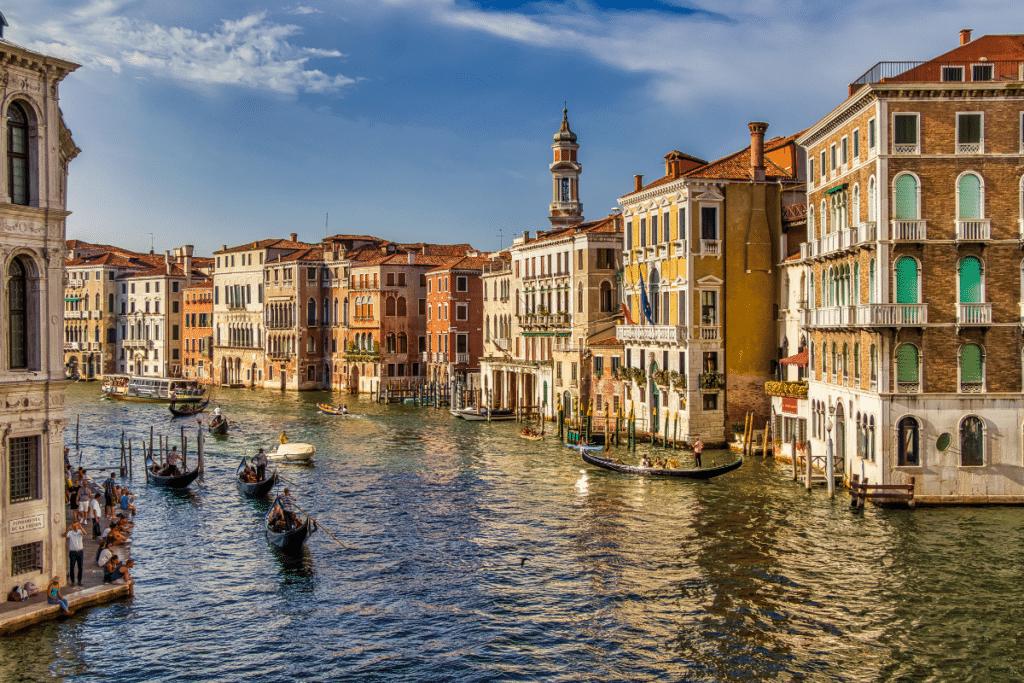
Best Reached By Train: For Art and History Lovers
Venice, Veneto (Northern Italy)
Venice feels like stepping into a painting, with its maze of canals, bridges, and palazzos that have remained almost unchanged for centuries. The city’s rich Renaissance history is evident everywhere, from the grandeur of St. Mark’s Basilica to the impressive Doge’s Palace, both of which showcase Venice’s immense power during its prime.
There’s plenty for art lovers, with works by Titian and Tintoretto, and modern exhibitions like the Venice Biennale. Whether you’re exploring St. Mark’s Basilica or visiting the Peggy Guggenheim Collection, Venice offers art and history at every turn.
Getting around Venice is easy with its vaporetti (water buses), and you can easily visit the nearby islands of Murano (known for its glassmaking) and Burano (known for its lacemaking). With high-speed trains connecting Venice to other cultural cities like Padua, Verona, and Milan, you have endless options for exploring the region without needing a car.
Florence, Tuscany (Central Italy)
Florence is the birthplace of the Renaissance, and you can feel its influence everywhere you go. As you walk through the city, you’re surrounded by iconic landmarks like Brunelleschi’s Dome, the Uffizi Gallery, and Palazzo Vecchio—each telling the story of Florence’s incredible role in shaping European history.
The city’s deep ties to the Medici family and its role in nurturing world-renowned artists like Michelangelo make it a dream for anyone passionate about art and history. Whether you’re admiring Michelangelo’s David or wandering through the Accademia and Uffizi, Florence feels like an open-air museum.
Getting around Florence is easy and enjoyable—most of its incredible sites are within walking distance and the public buses and trams are simple to navigate. Florence’s central train station makes it effortless to hop on a train and visit nearby gems like Siena, Lucca, Pisa, or even Rome.
Further Reading:
• 9 Things To Know Before Planning Your Dream Tuscany Trip
Rome, Lazio (Central Italy)
Rome is like stepping into a living museum if you love art and history. You can walk through ancient Roman ruins, stand in awe of Renaissance masterpieces, and explore stunning baroque churches—all in one day. From the majestic Colosseum and Roman Forum to the breathtaking Sistine Chapel in the Vatican Museums, every corner of the city takes you on a journey through time. Rome’s unique mix of ancient ruins, Renaissance art, and baroque architecture, like St. Peter’s Basilica, gives you a rich and immersive experience into centuries of culture that’s hard to match.
Getting around Rome is easy, thanks to its public transport system. The metro, buses, and trams connect you to all the iconic spots, making it simple to hop between the Colosseum, St. Peter’s, and the Vatican. Rome’s train network makes it easy to take day trips to places like Florence, Naples, or Orvieto.

Best Reached By Car: For Art and History Lovers
Assisi, Umbria (Central Italy)
More than just the birthplace of St. Francis, Assisi is a UNESCO World Heritage site filled with cultural and religious significance. The stunning Basilica di San Francesco is the highlight, where you can admire breathtaking frescoes by Giotto and Cimabue that vividly depict the life of St. Francis. As you wander through Assisi’s medieval streets, you’ll be surrounded by beautiful architecture and an peaceful atmosphere that’s hard to describe.
Having a car in Assisi offers you the freedom to explore the stunning Umbria region at your own pace. With a car, you can take day trips to nearby towns like Spello, Gubbio, and Perugia, each with its own unique art and history waiting to be discovered. The scenic drives through the rolling hills of Umbria are breathtaking, leading you to charming villages, vineyards, and picturesque landscapes.
Matera, Basilicata (Southern Italy)
Matera is unlike any other place in Italy, famous for its sassi—ancient cave dwellings carved into the rock that have been inhabited since prehistoric times. Walking through these caves feels like stepping back thousands of years, offering you a rare glimpse into early human life in Italy. As a UNESCO World Heritage site, Matera is one of the most unique and fascinating destinations for history lovers, allowing you to connect with an ancient past in an incredibly tangible way.
Having a car in Matera provides the flexibility to explore the surrounding historical towns like Altamura and Gravina in Puglia, both celebrated for their ancient history and striking stone architecture. You can also take a short drive to Metaponto to see the impressive ancient Greek ruins.
Taormina, Sicily (Southern Italy)
Taormina offers the perfect blend of cultural heritage, scenic beauty, and historical richness, making it an ideal destination for art and history lovers. The town is home to the impressive Greek Theatre, a historical landmark that boasts incredible views of Mount Etna and the Ionian Sea. This combination of cultural significance and natural beauty sets Taormina apart as a truly unique destination in Sicily. The town itself exudes charm with its medieval streets, historic churches, and lively cultural scene.
Taormina is also a convenient base for exploring eastern Sicily by car. From here, you can easily reach Mount Etna, with its fascinating geological features and deep connection to mythology, as well as the nearby towns of Savoca and Giardini Naxos. Syracuse is only an 1 hour and 30 minutes way, known for its rich historical heritage, stunning architecture, and vibrant atmosphere, particularly in the old town of Ortigia, where ancient ruins coexist with lively markets and picturesque waterfront views.
Best Places to Stay In Italy For Nature Lovers & Coastal Enthusiasts
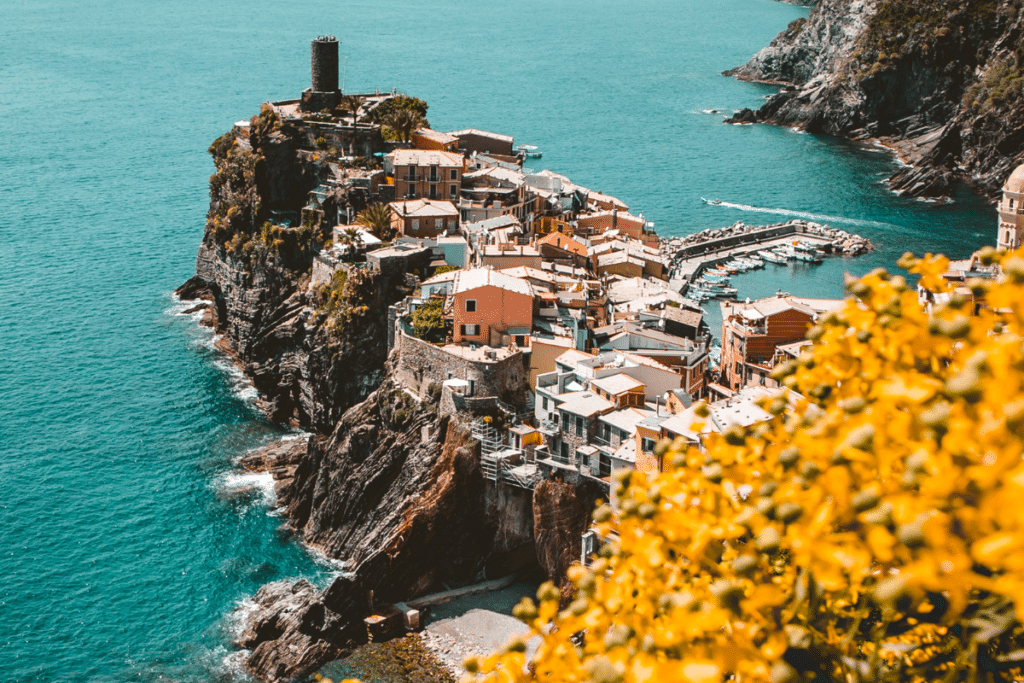
Best Reached By Train: For Nature Lovers & Coastal Enthusiasts
Cinque Terre, Liguria (Northern Italy)
Cinque Terre, in Liguria, is a dream destination for nature lovers who want to experience Italy without the hassle of a car. If you’re planning to stay here, Vernazza or Manarola make fantastic bases. Picture yourself hiking along coastal trails with breathtaking views, swimming in the crystal-clear Mediterranean, and exploring five colorful villages, each with its own unique character. The entire area feels like it was made for walking, and the excellent train system connects Vernazza, Manarola, and the other villages, making it easy to hop between them. You can truly enjoy the charm of these scenic towns at your own pace, taking in the stunning landscapes along the way.
Getting around Cinque Terre couldn’t be easier. The regional train links all five villages and offers connections to nearby cities like La Spezia and Genoa, allowing you to explore the surrounding areas effortlessly. Hiking the famous Sentiero Azzurro (Blue Trail), which connects the villages, is one of the best ways to soak in those spectacular views of the coastline. Whether you’re trekking through terraced vineyards, taking leisurely strolls along the coastal paths, or simply relaxing by the sea, Cinque Terre is the perfect escape for anyone wanting to reconnect with nature in a truly breathtaking setting.
Lake Como, Lombardy (Northern Italy)
Lake Como, in Lombardy, is an incredible destination for nature lovers who want to explore without the hassle of a car. Varenna makes for a perfect home base—it’s scenic, peaceful, and conveniently connected to Milan by direct train. The area’s frequent ferries make it easy to hop between the picturesque lake towns, so you can fully experience Lake Como’s natural beauty. Whether you want to relax, explore charming villages, or wander along the lakeside paths, Varenna is an ideal choice for discovering everything Lake Como has to offer.
Getting around Lake Como is easy and enjoyable. Varenna’s train station provides connections to Milan and nearby towns like Lecco, while ferries and boats make exploring other charming spots like Bellagio and Menaggio a breeze. You can enjoy lakeside hikes, visit attractions like Villa Monastero and Castello di Vezio, or take leisurely boat rides to admire the stunning views around the lake.
Amalfi Coast, Campania (Southern Italy)
The Amalfi Coast is famous for its dramatic cliffs, lush terraced gardens, and stunning coastal views, all of which can be explored through a network of hiking trails that connect the towns. The Path of the Gods (Sentiero degli Dei) is a must-do hike, offering incredible views of the Mediterranean and the chance to wander through charming small villages. With the easy availability of local buses and ferries, you can enjoy outdoor adventures without needing a car.
For a home base, Sorrento makes an excellent choice. It’s well-connected by train to Naples and has frequent buses and ferries that provide easy access to Amalfi, Positano, and Ravello. Staying in Sorrento allows you to enjoy the beautiful coastal scenery while being in a town that is more accessible and less hectic compared to some of the smaller coastal villages. With excellent public transport options, you’ll can explore the natural beauty of the Amalfi Coast, whether it’s hiking along coastal trails, visiting the islands of Capri and Ischia, or simply taking in the breathtaking views from different vantage points along the coast.
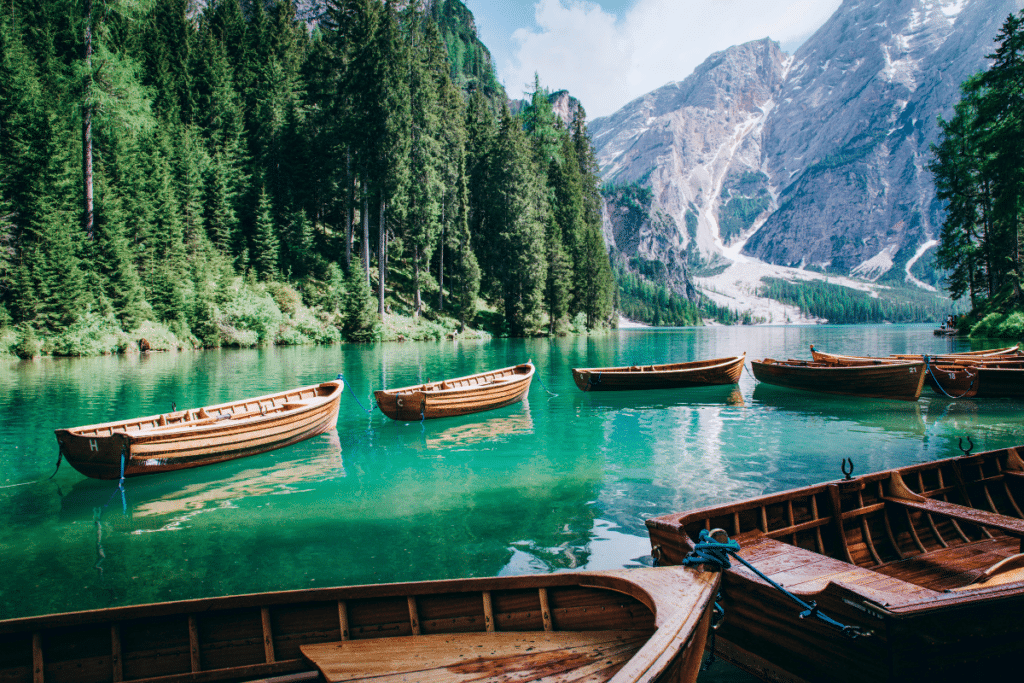
Best Reached By Car: For Nature Lovers & Coastal Enthusiasts
Dolomites (Northern Italy)
The Dolomites are an outdoor lover’s paradise, offering some of the most stunning mountain scenery in all of Italy. Driving here means you have the flexibility to explore dramatic mountain passes, tranquil valleys, and crystal-clear lakes at your own pace. The area is perfect for hiking, with famous trails like Tre Cime di Lavaredo and Alpe di Siusi. In winter, the Dolomites transform into a skiing wonderland, with world-class ski resorts offering endless opportunities to hit the slopes. Beyond skiing and hiking, you can also enjoy mountain biking, rock climbing, and scenic drives.
Cortina d’Ampezzo and Ortisei are great bases for exploring the Dolomites. Cortina is known for its chic vibe and easy access to some of the region’s best hiking and skiing areas, while Ortisei offers a more relaxed atmosphere with beautiful alpine charm. Roads in the Dolomites are well-maintained but can be steep and winding, especially on mountain passes like Passo Pordoi. Driving here is incredibly rewarding, but it’s best to be prepared for narrow roads and changing weather conditions.
Umbria (Central Italy)
Umbria, the region that’s called the “Green Heart of Italy,” is a fantastic destination for nature lovers traveling with a car. This lush, scenic region is filled with rolling hills, dense forests, and beautiful lakes, offering endless opportunities for exploration. With a car, you can easily navigate the rural landscapes, uncovering hidden gems and visiting some of the region’s most stunning natural areas. Monte Sibillini National Park is perfect for hiking, with trails that lead through dramatic mountainscapes, while Lake Trasimeno offers serene lakeside views, swimming spots, and picnic areas. Driving also gives you access to beautiful hilltop towns like Orvieto, Spello, Gubbio, and Norcia—each surrounded by breathtaking nature.
For a home base, Assisi or Spello are great options. Both towns offer easy access to hiking trails in the surrounding hills and are centrally located for exploring Umbria’s natural beauty. Staying in Assisi allows you to enjoy the scenic drives through the countryside while having quick access to Monte Subasio’s trails and beautiful landscapes. Spello offers a similar experience with a slightly quieter feel, providing a peaceful atmosphere as you set out on day trips to the area’s national parks, rivers, and valleys.
Sardinia (Southern Italy)
The island of Sardinia is a paradise for nature lovers, coastal enthusiasts, and beachgoers, especially if you have a car to explore. It’s diverse landscapes feature rugged coastlines, crystal-clear waters, and picturesque mountains—perfect for outdoor adventures.
Cala Gonone is an ideal base for those who love kayaking, coastal hikes, and boat trips, with access to stunning spots like Cala Luna. For a laid-back beach experience, Chia offers some of Sardinia’s best beaches, featuring golden sands, shallow turquoise waters, and dunes. A few more home base options are Alghero, a vibrant town with beautiful coastal views. And for a bit of coastal luxury, Costa Smeralda’s glamorous beaches with Porto Cervo as a home base.
Having a car is necessary to experience Sardinia. Many of the island’s best spots—like hidden coves, mountain viewpoints, and national parks like Gennargentu—are off the beaten path and not easily reached without a vehicle. The well-maintained yet winding coastal roads make for scenic drives, allowing you to visit untouched beaches, charming villages, and La Maddalena Archipelago for a quieter escape.
Puglia (Southern Italy)
Puglia is a dream destination for coastal enthusiasts. With its stunning coastline, dramatic cliffs, and secluded beaches, the region offers plenty of opportunities to experience both the Adriatic and Ionian Seas. You’ll be surrounded by it’s whitewashed buildings that make you feel like you’re in another world. The days seem to go by slower in Puglia. It’s one of my favorite regions.
Having a car is necessary to discover all that Puglia has to offer—whether it’s a secluded beach, a picturesque fishing village, or an olive grove overlooking the sea. For home bases I recommend Polignano a Mare, known for its dramatic cliffs and beautiful beaches, and Otranto, where you can enjoy coastal walks, crystal-clear waters, and historical sites.
Sicily (Southern Italy)
If you’re a nature lover or coastal enthusiast planning to drive through the island of Sicily, you’re in for an amazing experience. For a perfect home base, you might want to consider staying in Taormina on the east coast. You’ll get those breathtaking views, enjoy the beautiful Isola Bella beach, and have easy access to Mount Etna’s incredible landscapes. If you’re leaning toward the northern coast, Cefalù is another fantastic option. Its long sandy beach and relaxed coastal vibe make it the ideal spot to unwind while still allowing you to explore the surrounding area. And if you’re drawn to the rugged beauty of the south, Agrigento is perfect, with its proximity to the Scala dei Turchi and the stunning natural reserves along the coast.
With a car, you can reach some of Sicily’s most beautiful spots. The Zingaro Nature Reserve, for example, has coastal trails that lead to hidden coves with crystal-clear waters. Vendicari Nature Reserve offers untouched beaches and a chance to observe local wildlife. You can even drive up to Mount Etna and experience its volcanic landscapes firsthand. By having your own car, you can make the most of Sicily’s natural beauty, hop between scenic coastal towns, enjoy hikes, and discover the island’s more secluded spots that most tourists miss.
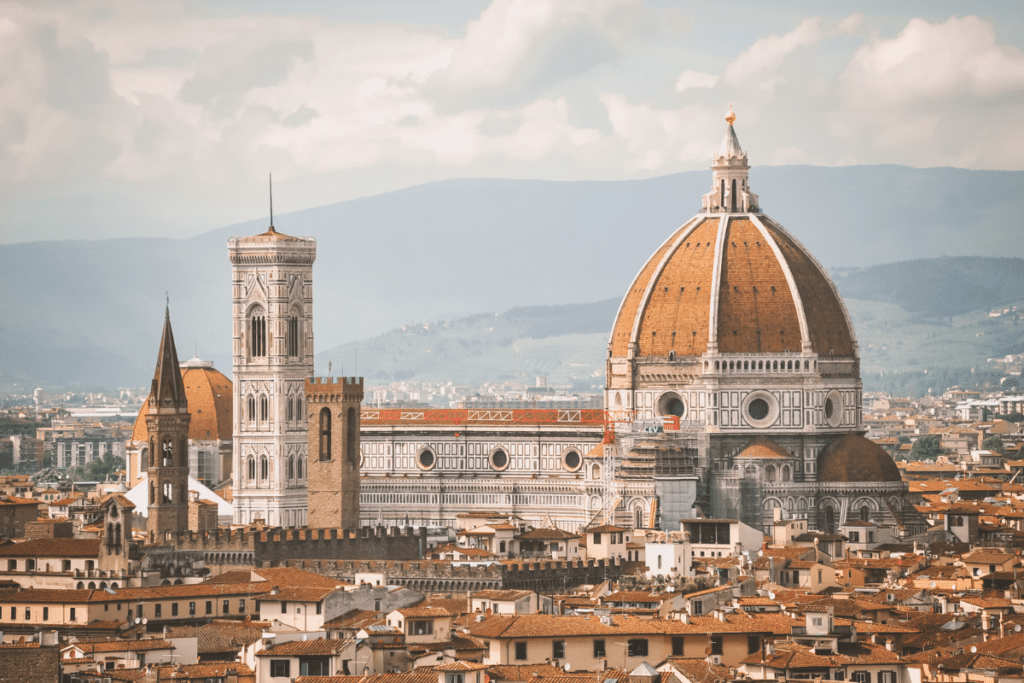
Conclusion
Deciding where to stay in Italy isn’t a one-size-fits-all decision—it depends on how you want to explore the country and what you’re passionate about. Whether you’re driving or taking the train, and whether you’re drawn to food, wine, history, or the outdoors, there’s a perfect spot for you. The key is to tailor your stay to your interests, so you can fully experience Italy in a way that feels personal and meaningful.
Be sure to check out my post on how to plan an authentic trip to Italy. And don’t forget to grab my free guide, “9 Mistakes to Avoid When Planning an Italy Trip,” to help make sure your trip is smooth and stress-free!

